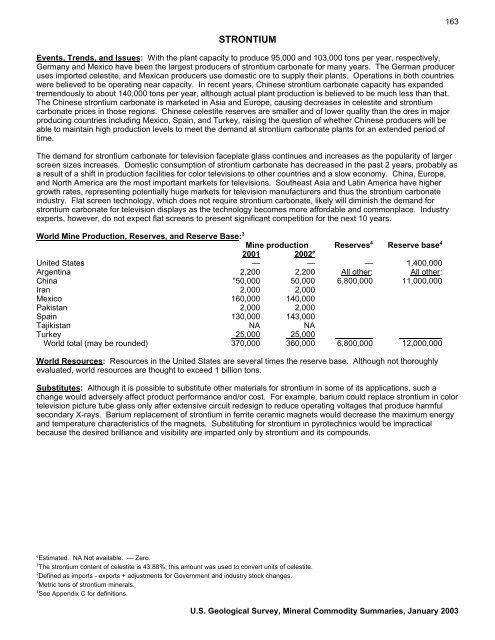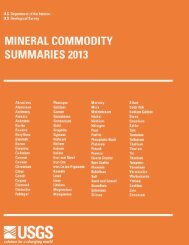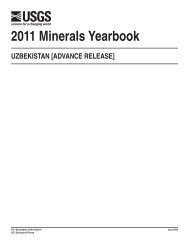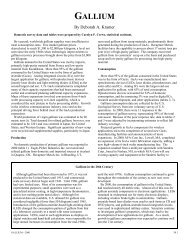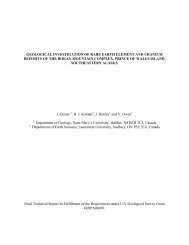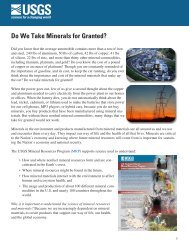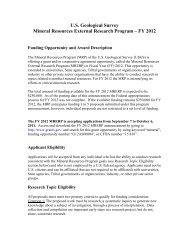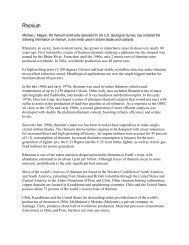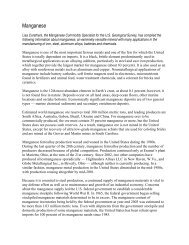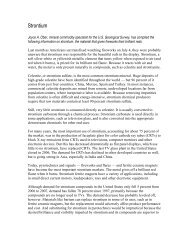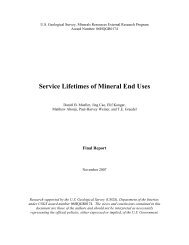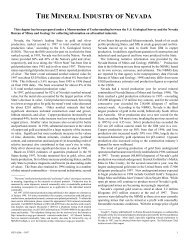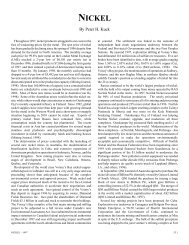Mineral Commodity Summaries 2003 - Mineral Resources Program ...
Mineral Commodity Summaries 2003 - Mineral Resources Program ...
Mineral Commodity Summaries 2003 - Mineral Resources Program ...
Create successful ePaper yourself
Turn your PDF publications into a flip-book with our unique Google optimized e-Paper software.
STRONTIUM<br />
Events, Trends, and Issues: With the plant capacity to produce 95,000 and 103,000 tons per year, respectively,<br />
Germany and Mexico have been the largest producers of strontium carbonate for many years. The German producer<br />
uses imported celestite, and Mexican producers use domestic ore to supply their plants. Operations in both countries<br />
were believed to be operating near capacity. In recent years, Chinese strontium carbonate capacity has expanded<br />
tremendously to about 140,000 tons per year, although actual plant production is believed to be much less than that.<br />
The Chinese strontium carbonate is marketed in Asia and Europe, causing decreases in celestite and strontium<br />
carbonate prices in those regions. Chinese celestite reserves are smaller and of lower quality than the ores in major<br />
producing countries including Mexico, Spain, and Turkey, raising the question of whether Chinese producers will be<br />
able to maintain high production levels to meet the demand at strontium carbonate plants for an extended period of<br />
time.<br />
The demand for strontium carbonate for television faceplate glass continues and increases as the popularity of larger<br />
screen sizes increases. Domestic consumption of strontium carbonate has decreased in the past 2 years, probably as<br />
a result of a shift in production facilities for color televisions to other countries and a slow economy. China, Europe,<br />
and North America are the most important markets for televisions. Southeast Asia and Latin America have higher<br />
growth rates, representing potentially huge markets for television manufacturers and thus the strontium carbonate<br />
industry. Flat screen technology, which does not require strontium carbonate, likely will diminish the demand for<br />
strontium carbonate for television displays as the technology becomes more affordable and commonplace. Industry<br />
experts, however, do not expect flat screens to present significant competition for the next 10 years.<br />
World Mine Production, Reserves, and Reserve Base: 3<br />
Mine production Reserves 4<br />
Reserve base 4<br />
2001 2002 e<br />
United States — — — 1,400,000<br />
Argentina 2,200 2,200 All other: All other:<br />
China<br />
e<br />
50,000 50,000 6,800,000 11,000,000<br />
Iran 2,000 2,000<br />
Mexico 160,000 140,000<br />
Pakistan 2,000 2,000<br />
Spain 130,000 143,000<br />
Tajikistan NA NA<br />
Turkey 25,000 25,000<br />
World total (may be rounded) 370,000 360,000 6,800,000 12,000,000<br />
World <strong>Resources</strong>: <strong>Resources</strong> in the United States are several times the reserve base. Although not thoroughly<br />
evaluated, world resources are thought to exceed 1 billion tons.<br />
Substitutes: Although it is possible to substitute other materials for strontium in some of its applications, such a<br />
change would adversely affect product performance and/or cost. For example, barium could replace strontium in color<br />
television picture tube glass only after extensive circuit redesign to reduce operating voltages that produce harmful<br />
secondary X-rays. Barium replacement of strontium in ferrite ceramic magnets would decrease the maximum energy<br />
and temperature characteristics of the magnets. Substituting for strontium in pyrotechnics would be impractical<br />
because the desired brilliance and visibility are imparted only by strontium and its compounds.<br />
e Estimated. NA Not available. — Zero.<br />
1 The strontium content of celestite is 43.88%; this amount was used to convert units of celestite.<br />
2 Defined as imports - exports + adjustments for Government and industry stock changes.<br />
3 Metric tons of strontium minerals.<br />
4 See Appendix C for definitions.<br />
163<br />
U.S. Geological Survey, <strong>Mineral</strong> <strong>Commodity</strong> <strong>Summaries</strong>, January <strong>2003</strong>


